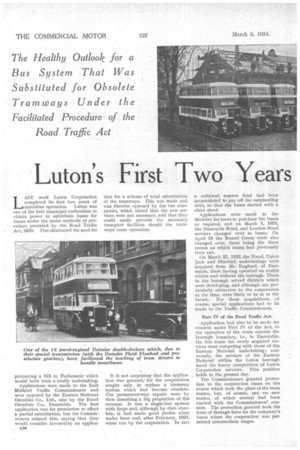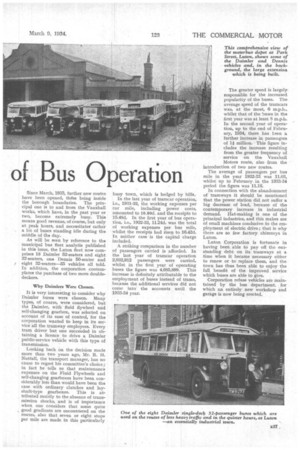Luton's First Two Years of Bus Operation
Page 102

Page 103

If you've noticed an error in this article please click here to report it so we can fix it.
LAST week Luton Corporation completed its first two years of motorbus operation. Luton was one of the first municipal authorities to obtain power to substitute buses for trams under the easier methods of procedure provided by the Road Traffic Act, 1930. This eliminated the need for
promoting a Bill in Parliament which would have been a costly undertaking.
Applications were made to the East Midland Traffic Commissioners and were opposed by the Eastern National Omnibus Co., Ltd., also by the Excel Omnibus Co., Dunstable. The first application was for permission to effect a partial substitution, but the Commissioners refused this, saying that they would consider favourably an applica
E36 tion for a scheme of total substitution of the tramways. This was made and was likewise opposed by the bus companies, which stated that the new services were not necessary, and that they could easily provide the necessary transport facilities should the tramways cease operation.
It is not surprising that the application was granted, for the corporation sought only to replace a tramway system which had become obsolete. The permanent-way repairs were by then absorbing a big proportion of the revenue. It was a single-line system with loops and, although by then obsolete, it had made good profits when under lease and, after February, 1923, when run by the corporation. In fact a sufficient reserve fund had been accumulated to pay off the outstanding debt, so that the buses started with a clean sheet.
Applications were made to the Ministry for loans to purchase the buses as required, and on March 1, 1931, the Dunstable Road, and London Road services changed over to buses. On April 18 the Round Green route also changed over, these being the three routes on which trams had previously been run.
On March 23. 1933, the Excel, Union Jack and Bluebird undertakings were acquired from Mr. England, of Dunstable, these having operated on routes within and without the borough. Those in the borough served districts which were developing, and although not particularly attractive to the corporation at the time. were likely to be so in the future. For these acquisitions, Of course, special applications had to be made to the Traffic Commissioners.
Part IV of the Road Traffic Act.
Application had also to be made for consent under Part IV of the Act, to the operation of the route outside the borough boundary, i.e., to Dunstable. On this route the newly acquired services were competing with those of the Eastern National undertaking; conversely, the services of the Eastern National within the Luton borough faced the heavy competition of Luton Corporation services. This position holds to the present day.
The Commissioners granted protection to the corporation buses on the routes which took the place of the tram routes, but, of course, not on new routes, of which several had been started with the Commissioners' consent. The protection granted took the form of through fares for the company's buses where the corporation was permitted intermediate stages. Since March, 1933, further new routes have been opened, these being inside the borough boundaries. The principal one is to and from the Vauxhall works, which have, in the past year or two, become extremely busy. This means good revenue, of course, but only at peak hours, and necessitates rather a lot of buses standing idle during the middle of the day.
M will be seen by reference to the municipal bus fleet analysis published in this issue, the Luton fleet now comprises 18 Daimler 52-seaters and eight 32-seaters, one Dennis 50-seater and eight 32-seaters-35 vehicles all told. In addition, the corporation contemplates the purchase of two more doubledeckers.
Why Daimlers Were Chosen.
It is very interesting to consider why Daimler buses were chosen. Many types, of course, were considered, but the Daimler, with fluid flywheel and self-changing gearbox, was selected on account of its ease of control, for the corporation wanted to keep in its service all the tramway employees. Every tram driver but one succeeded in obtaining a licence to drive a Daimler public-service vehicle with this type of transmission.
Looking back on the decision made more than two years ago, Mr. R. H. Nuttall, the transport manager, has no cause to regret his committee's choice; in fact he tells us that maintenance expenses on the Fluid Flywheels and self-changing gearboxes have been considerably less than would have been the case with ordinary clutches and layshaft-type gearboxes. This is attributed mainly to the absence of transmission shocks, and is of importance when one considers that some quite good gradients are encountered on the routes, also that seven or eight stops per mile are made in this particularly busy town, which is hedged by hills.
In the last year of tramcar operation, i.e., 1931-32, the working expenses per car mile, including power costs, amounted to 10.80d. and the receipts to 15.48d. In the first year of bus operation, i.e., 1932-33, 11.24d. was the total of working expenses per bus mile, whilst the receipts had risen to 16.42d. In neither case is the capital charge included.
A striking comparison in the number of passengers carried is afforded. In the last year of tramcar operation 2,932,912 passengers were carried, whilst in the first year of operating buses the figure was 4,685,899. This increase is definitely attributable to the employment of buses instead of trams, because the additional services did not come into the accounts until the 1933-34 year.
The greater speed is largely, responsible for the increased popularity of the buses. The average speed of the tramcars was, at the most, 6 m.p.h., whilst that of the buses in the first year was at least 8 m.p.h. In the second year of operation, up to the end of February, 1934, there has been a further increase in passengers of 14 million. This figure includes the increase resulting from the greater frequency of service on the Vauxhall Motors route, also from the introduction of two new routes.
The average of passengers per bus mile in the year 1932-33 was 11.03, whilst up to Februaiy in the 1933-34 period the figure was 11.16.
In connection with the abandonment of tramways it should be mentioned that the power station did not suffer a big decrease of load, because of the contemporary increase in industrial demand. Hat-making is one of the principal industries, and this makes use of small machines conducive to the employment of electric drive ; that is why there are so few factory chimneys in Luton.
Luton Corporation is fortunate in having been able to pay off the outstanding debt on its tramways at a time when it became necessary either to renew or to replace them, and the town has thus been able to enjoy the full benefit of the improved service which buses are able to give.
Corporation refuse vehicles are maintained by the bus department, for which an entirely new workshop and garage is now being erected.












































































































































































